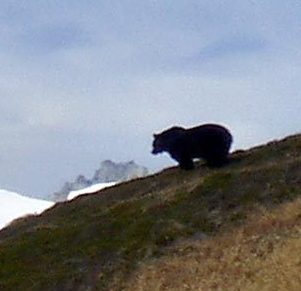Bear experts resume search for North Cascades grizzlies
WILDLIFE -- Teams of wildlife biologists have begun the second year of effort to determine the status of grizzly bears in the North Cascades.

U.S. Forest Service, U.S. Fish and Wildlife Service, Washington Department of Fish and Wildlife, and Western Transportation Institute biologists are using remote-controlled cameras and hair snares spread across about 9,500 square miles in North Central Washington.
Some teams will be working this summer in the Upper Cascade River watershed where a hiker photographed an animal in October that an interagency panel of grizzly bear experts confirmed was a grizzly bear. The U.S. Fish and Wildlife Service announced last week it was the first confirmed grizzly bear sighting in the North Cascades since 1996.
Read on for details about the research, which is having a boost of enthusiasm now that the photos have confirmed grizzlies have been using the area.
"In the wake of these photographs, this analysis is more significant because information from our efforts will be used to evaluate options for addressing grizzly recovery in the North Cascades," said Lead Project Biologist Bill Gaines, Ph.D. "Knowing the location of a confirmed sighting helps focus our efforts."
During the first year of the study, biologists deployed 191 hair snares and 47 remote-controlled cameras in secluded parts of the North Cascades. The first year of the effort covered about nine percent of the 9,500 square-mile study area.
Scientists sent about 900 bear hair samples to a genetics lab for analysis and identified 218 individual black bears, but no grizzly bears.
They also reviewed more than 6,500 digital photos from remote-controlled cameras they erected at some hair snare sites. Images showed about 130 different black bears of different sizes and color, but none were determined to be grizzly bears.
Gaines said he was hopeful a grizzly bear might be detected in the first year, but results did not surprise him because the study area is so large and the effort is only in its first year. He said if similar efforts are carried out in 2011 and 2012, about 25 to 30 percent of the study area could be sampled with efforts focused in the best habitat.
The study area is one of the largest contiguous blocks of federal land in the lower 48 states, stretching from the Canadian border south to Interstate 90. It encompasses the Okanogan-Wenatchee National Forest, Mt.
Baker-Snoqualmie National Forest and North Cascades National Park. Much of it lies in rugged, remote country such as the Pasayten, Alpine Lakes and Glacier Peak Wilderness Areas.
Scientists with the North Cascades Interagency Grizzly Bear Study Team selected the sites based upon knowledge of quality grizzly habitat, accessibility to remote sites and frequency of reputable sightings.
The current status and distribution of grizzly bears in the North Cascades has not been investigated for many years and is one of the objectives of the study.
Another interagency team of scientists completed the last search for North Cascades grizzlies in 2000 when they completed a study using hair snares on both sides of the border and documented one Canadian grizzly.
Their study only covered a small portion of the recovery area.
North Cascades ecosystem grizzlies have been protected in both countries for decades, but the population has not recovered from extremely low numbers. The U.S. Fish and Wildlife Service estimates adjacent British Columbian populations to be less than 25 to 30 grizzlies.
Other North Cascades Grizzly Bear Study Team members include Robert Long, Ph.D., with the Western Transportation Institute at Montana State University, and Washington Department of Fish and Wildlife Biologist Scott Fitkin.
Seattle City Light, the U.S. Fish and Wildlife Service and the U.S.
Forest Service are funding the study, along with grant funding. The study could be extended additional years, depending upon funding.
The monitoring work is necessary because since 1975 the U.S. Fish and Wildlife Service has listed grizzlies in the lower 48 states as a threatened species and grizzly bears in the North Cascades have been determined to be warranted for endangered status, but precluded due to other listing priorities.
The study will also assist the Cascades Carnivore Connectivity Project, a multi-agency effort to evaluate and enhance habitat connectivity for carnivores in the North Cascades.
The Endangered Species Act requires the U.S. Fish and Wildlife Service to conduct reviews of threatened and endangered species at least once every five years to determine if listed species should be delisted or reclassified.
The use of snares to collect hair for DNA sampling has become a widely used and accepted technique in wildlife management, according to Gaines. He said DNA analysis can identify individual grizzlies, determine their sex and even measure stress levels. It is also much safer and less expensive to conduct research this way.
Gaines, Long, Fitkin and other experienced wildlife biologists trained and supervised detection team members to ensure data quality control for all hair samples. Team members also deployed remote-controlled cameras at some sites to detect other carnivores, such as cougars, wolves and wolverines that do not leave hair on snares.
